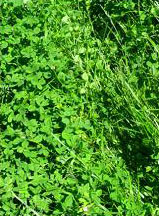Inoculating Legume Seed

Although there are many benefits of using legumes in pastures, one of the most desirable is the ability of these plants to fix atmospheric nitrogen. This can increase yields and quality while significantly reducing fertilizer costs. Nitrogen fixation is the result of the symbiotic relationship between the plant and rhizobium bacteria. Rhizobia form nodules on the roots of the plant and allow the plant to convert atmospheric nitrogen into a form of nitrogen that can be utilized by plants.
The amount of nitrogen fixed depends on the species, time of year, and growing conditions. To get full use of the advantages of nitrogen fixation, legume seed should be inoculated before planting.
Inoculation is introducing the rhizobia into the forage system by applying it to the seed before planting. While it is possible to establish legume stands without inoculating, forage yield and amount of nitrogen fixed are greatly reduced. It can even be necessary to apply nitrogen to the stand established from uninoculated seed to supply adequate fertility to the forage plants. Although the bacteria may persist in the soil for 2 to 5 years, it is recommended that inoculation is done each time seed is planted to ensure inoculation.
Inoculant, which is usually a mixture of the bacteria and peat, can be purchased and applied to seed. Pre-inoculated seed can also be purchased from various seed vendors. It is vital that the best methods are used when applying inoculant to seed, during storage, and during planting. Different types of bacteria are used for different species of legumes. Be sure to purchase the correct inoculant for the species being planted. It is essential that the bacteria have contact with the roots. To accomplish this, the seed needs to be adequately coated with the inoculant. A sticking agent should be applied to seed before the inoculant is applied. Some inoculants come with a clay to attach bacteria to the seed coat. A commercial sticking agent can be purchased separately or can be made from syrup or molasses and water.
Lastly, the bacteria must be alive in order to infect roots and fix nitrogen. Be sure to read the label before purchasing inoculant or pre-inoculated seed. Do not purchase if the expiration date has passed. The inoculant needs to be stored properly to keep bacteria alive. Ideally, the bacteria or rhizobia should be stored in a refrigerator or cool area. High temperatures and exposure to sunlight can kill the bacteria. Seed should be planted quickly after inoculant is applied. Also, inspect the condition of the package to be sure that there is no severe damage or holes which may allow the bacteria and peat to dry. Using proper methods to handle and store inoculant and seeds will help ensure proper inoculation. More details on proper inoculation techniques can be found in the UK publication Inoculation of Forage Legumes.
Legumes can increase pasture quality and yield as well as fix nitrogen in the soil. Nitrogen fertilizer is not needed in healthy legume stands and the legumes can supply nitrogen for other forages in the pasture as well. To obtain the full advantage of nitrogen fixation, inoculate seeds before each planting.
Categories:
General
Establishment/Renovation


